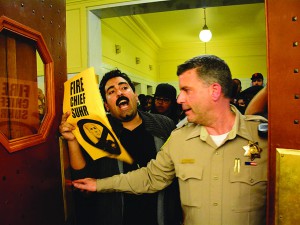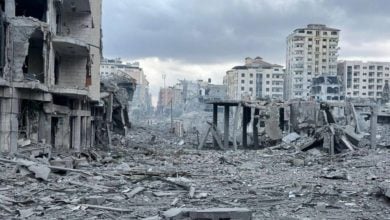
“Everything police do in a police state is legal.” – Mumia Abu Jamal
The firing-squad execution of 26-year-old Mario Woods by the San Francisco Police Department has ignited both a people’s movement for justice and a verbal police backlash against that movement that is rooted in the most violent delusions of “law and order” and white supremacy.
Spearheading the attacks on protesters, labor unions backing the calls for justice and city officials who have criticized some police actions is the president of the San Francisco Police Officers Association, Martin Halloran, who issued a statement on New Year’s Day entitled, “The Truth Shall Be Known.” In this letter he refers to those angry with Woods’ murder as “ignorant” “sheep” that fail to understand the police version of events as “facts,” despite there being documented video of the murder from three different angles.
Halloran ends the letter with a quote that sums up his idea of the role of police: “There is no ‘nice’ way to arrest a potentially dangerous, combative suspect. The police are our bodyguards, our hired fists, batons, and guns. We pay them to do the dirty work of protecting us, the work we’re too afraid to do, too unskilled to do, or too civilized to do ourselves. We expect them to keep the bad guys out of our businesses, cars, and homes, out of our faces. We want police to ‘take care of the problem.’ We just don’t want to see how it’s done.”
From the very first sentence Halloran admits that the police know nothing other than violence. It is important that those fighting systemic racism learn from these words to understand the true role of police in the United States. Since the introduction of the police in settler-colonial America, their role has been in part the protection of private property. Originally, slaves owned by the white male land-owning class were considered to be private property, but now, as Halloran alludes, private property means things like “businesses, cars, and homes.” The ownership of real private property, wealth-producing capital, is only attainable for the rich.
While some poor and working-class people in San Francisco do own vehicles, owning a home in the city is next to impossible. There are many people with no other option than to live out of their cars or make the choice to rent an outrageously priced room or living space from profit-driven landlords. Owning a small business also is increasingly difficult, as San Francisco has no commercial rent control, allowing the largest developers to snatch up commercial space through dubious means. Not to mention that Black-owned businesses were mostly gutted from the City in the redevelopment period of the 1950s.
This leaves a wealthy bourgeoisie that the San Francisco Police Department “protects and serves.” Who qualifies as “the bad guys” to the police? Undoubtedly, it is communities of color and the City’s poor and destitute. Once again, we can look to the POA to proudly trumpet this racist hostility themselves. In one of the PR videos available on their website, entitled “From Baghdad to Bayview,” the POA boasts of having an Iraq war veteran patrolling the streets of Bayview-Hunter’s Point, the district in which Mario Woods was murdered.
Just as the U.S. military criminally invaded and occupied the sovereign territory of Iraq and terrorized their population, police forces domestically are charged with the same role, terrorizing poor, working, and oppressed people. The capitalist system necessarily ensures mass poverty exists while wealth accumulates in the hands of a tiny grouping of ruling-class elites. Rampant mental illness, homelessness, and desperation are the result of the profit-driven economy, while militarized policing serves to sweep the poor into the prison-industrial complex. Only the socialist reorganization of the economy that plans to meet the needs of the population, alongside the complete abolition of existing police structures can change this dynamic.
It is easy to identify the violently repressive narrative of the POA, but one must look deeper to find it in the carefully crafted language of SF Police Dept. Chief Greg Suhr and Mayor Ed Lee. In the wake of Mario Woods’ murder, Suhr travelled to Washington D.C. to study de-escalation techniques used in other countries by police. Suhr has used this trip to brand himself as an innovator in the police department who is responsive to the community. His narrative upon returning from D.C. revolves around how to handle people with “edged-weapons,” such as knives.
In no way does this address the systemic racism built in to the police, and only gives Suhr and SFPD a different angle to come from when the next instance of police terror inevitably occurs. Mayor Lee has joined Suhr in welcoming the Department of Justice’s Office of Community Oriented Policing Services (COPS) investigation, which presents entirely voluntary suggestions to the police department for “collaborative reform.” This investigation would not have been initiated without the movement in the streets, but it is far less than what the Justice 4 Mario Woods Coalition is demanding: a truly independent investigation into Woods’ murder.
These weak attempts at pacification by Suhr and Lee must be countered by unified and militant mass actions to heighten the struggle to fire Suhr, have a truly independent investigation into Mario Woods’ murder, and get murder charges for the involved officers. For his role in this case and other crimes against the poor and working people of San Francisco, Lee should at the very least be targeted for removal from office.
Already, the leading forces in the movement have successfully shut down the Bay Bridge on Martin Luther King Jr. Day, disrupted the Mayor’s inauguration, speaking events, police commission meetings, and protested outside the homes of both Lee and Suhr. On January 30, a march was led on “Super Bowl City,” a corporate-sponsored encampment that has taken over a section of downtown and is guarded by hundreds of militarized police. Lee has used these cops to kick out the homeless in an effort to paint a rosy picture of the City to the rich who have flocked here for the Super Bowl.
With over $5 million invested by the City in hosting the Super Bowl, there is a golden opportunity for protests to grab the national spotlight in order to apply the necessary pressure against Lee and Suhr that they are so desperately trying to avoid. Even after the Super Bowl hysteria leaves the City, it will most likely require well-coordinated actions of mass civil disobedience and other strong showings of force to win the three demands presented by the Justice 4 Mario Woods Coalition.
The small victories won so far in the struggle, including the recognition by a unanimous vote of the S.F. Board of Supervisors of Mario Woods’ birthday (July 22) as “Mario Woods’ Day” in San Francisco, have not been the result of any City official’s campaign for justice, but are the direct result of people-powered struggle and disruption of business as usual. The movement cannot rely on ruling-class politicians to offer any meaningful semblance of justice, and instead must look to the militancy of anti-police brutality struggles in Ferguson, Baltimore, and elsewhere to achieve its aims.






